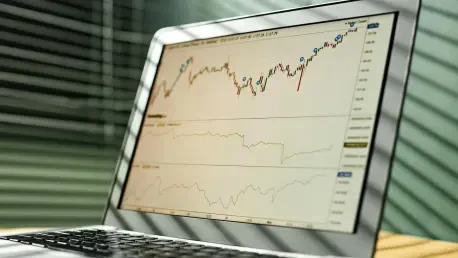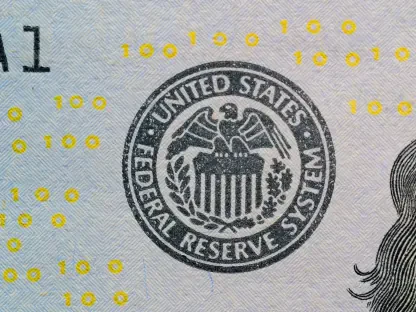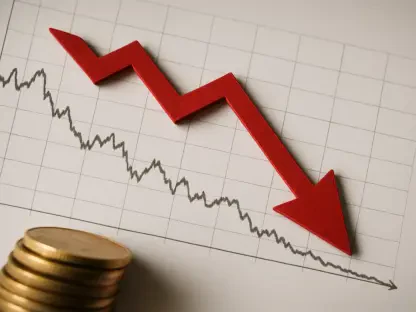A significant rally in the stock market has captured the attention of investors and analysts as the S&P 500 celebrates a remarkable 5-day winning streak. Various factors are driving this bullish sentiment, escalating stock prices, and reshaping investor outlooks. With the S&P 500 edging closer to erasing its year-to-date losses and achieving a nearly 5% increase from the prior Friday’s close, along with notable gains in the Dow Jones Industrial Average and Nasdaq Composite Index, market watchers are eager to dissect the influences behind this upward trend. The U.S.-China trade deal stands out as a primary catalyst, providing much-needed relief from long-standing trade tensions that have overshadowed economic growth prospects for both nations. This development, along with promising signals from inflation data, shifts in bond yields, and Federal Reserve policies, forms a complex landscape of intertwined economic factors that are fostering optimism among investors and financial institutions alike.
Impact of U.S.-China Trade Agreement
The U.S.-China trade agreement has emerged as a significant contributor to the current market rally, alleviating deep-seated fears over prolonged trade tensions between two of the world’s largest economies. The agreement includes a crucial 90-day pact where the U.S. agrees to reduce tariffs on Chinese goods to 30%, while China has committed to lowering duties on U.S. imports to 10%. Although it is not a comprehensive solution, this deal undeniably mitigates the apprehension of an escalating trade war that previously hindered market growth and economic stability. Wall Street’s reception of this development is mixed; commentators argue that while tariffs remain substantially higher than historical norms, the agreement provides a foundation for ongoing negotiations and stimulates renewed optimism for future resolution.
Investment giants like Goldman Sachs and Barclays have positively adjusted their market forecasts, recognizing diminished risks associated with a potential recession this year and anticipating a surge in economic growth and stock performance. Nonetheless, many acknowledge the trade deal as a temporary reprieve, raising questions about its sustainability and the long-term implications for the global economic landscape. As the ramifications of this trade agreement continue to unfold, investors remain vigilant, balancing optimism with caution and factoring in potential future shifts in trade policies that could either bolster or destabilize the buoyant market sentiment.
Influence of Inflation and Bond Yields
Inflation data has played a pivotal role in underpinning recent market optimism. April witnessed a cooler-than-anticipated increase in consumer prices, with rates rising by 2.3% year-over-year, marking the slowest pace since 2025. This decline in inflationary pressures has eased concerns over stagflation, a perilous combination of high inflation and stagnant economic growth, allowing a more optimistic economic forecast for the near term. Market analysts concur that while the challenge of curbing inflation persists, current data offers hope for a favorable environment conducive to economic activities. The Producer Price Index (PPI) further reinforces this outlook by showing an unexpected decline in April, indicating a continued abatement in inflation pressures.
The decline in the 10-year U.S. Treasury yield—a critical benchmark for lending—has reflected adjusted expectations regarding future interest rate cuts by the Federal Reserve, as anticipation grows for potential rate adjustments later this year. The FedWatch tool signals a 77% likelihood that the Federal Reserve will implement two additional rate cuts before year-end, thereby influencing bond yields and investor strategies. These dynamics underscore a market narrative of cautious optimism, where traders recalibrate their expectations based on fluctuating interest rate forecasts and inflation data, keeping a watchful eye on changing conditions. This intricate interplay between inflation metrics and interest rate projections continues to shape market sentiment and strategic investment decisions.
Prospective Market Dynamics and Investor Outlook
Market dynamics remain fluid, with investors navigating the rapid-paced changes in economic indicators and geopolitical developments that define the current investment landscape. The convergence of improved trade relations, moderated inflation rates, and revised monetary policies fuels an environment of cautious optimism, prompting analysts and economists to anticipate an era characterized by reduced macroeconomic risks and potential economic stability. Even amid the emerging positive indicators, themes of uncertainty persist as market participants remain vigilant about potential challenges on the horizon.
As temporary resolutions to trade issues evolve, stock market performance hinges on a balanced approach incorporating strategic adjustments to evolving economic landscapes. Analysts stress the importance of adopting a prudent perspective, recognizing the inherent volatility and transformative nature of global economics. This rally exemplifies the interconnectedness of geopolitical and economic factors, showcasing the complex web of strategic shifts driving investor sentiment and market performance during this period. This intricate ballet of market dynamics and informed speculation continues to shape the financial environment, with investors and analysts closely monitoring developments to anticipate future trends influencing stock valuations and portfolio strategies in the coming months and beyond.
Strategic Adjustments and Future Trajectories
The recent U.S.-China trade agreement has significantly contributed to the ongoing market rally, easing longstanding concerns over persistent trade tensions between two of the largest global economies. This agreement encompasses a pivotal 90-day period where the U.S. commits to lowering tariffs on Chinese imports to 30%, while China pledges to reduce duties on U.S. goods to 10%. While not a full resolution, this deal clearly alleviates fears of a worsening trade war, which previously hampered market growth and economic stability. Responses from Wall Street are mixed; experts suggest that while tariffs are still considerably high compared to historic levels, the agreement sets a stage for further discussions and enhances hope for a lasting resolution.
Managers at major financial firms like Goldman Sachs and Barclays have revised their forecasts, seeing reduced risks of an impending recession and expecting economic and stock growth. However, the agreement is viewed as a temporary fix, raising concerns about its durability and longer-term impacts on the global economy. As the implications unfold, investors are cautiously optimistic, balancing their outlook against possible future changes in trade policy that could influence market sentiment.









